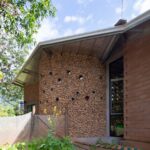Nestled within a vibrant Thai ethnic village, Na Khoang School embodies a harmonious blend of cultural richness and architectural innovation. Inspired by the surrounding natural landscape, the school’s design mirrors the rhythmic dance of flowers amidst mountains and hills.
Architectural Design
The school is divided into two sections: the Elementary part arranged along side corridors, and the preschool part clustered around middle corridors. These sections are interconnected by a communal stone stage, symbolizing unity and harmony with the terraced fields.

Innovative Construction
Na Khoang School’s walls are crafted from a variety of locally sourced materials, including unburnt terracotta bricks, degraded soil, and stream pebbles. This sustainable construction approach optimizes resource utilization, reduces environmental impact, and minimizes costs.
Environmental Considerations
The school’s design prioritizes environmental sustainability, providing a safe and comfortable learning environment throughout the year. Its architecture ensures warmth in winter and coolness in summer, fostering an environment conducive to learning and creativity.

Community Engagement
Beyond its educational function, Na Khoang School serves as a vital community space, hosting cultural activities, sports events, and gatherings after school hours. It acts as a hub for social interaction and community engagement, enhancing the village’s cultural vibrancy.
Conclusion
Na Khoang School stands as a testament to architectural innovation rooted in cultural heritage and environmental consciousness. By embracing nature-inspired design principles and sustainable construction practices, it not only provides a conducive learning environment but also fosters community cohesion and cultural preservation within the Thai ethnic village.




















